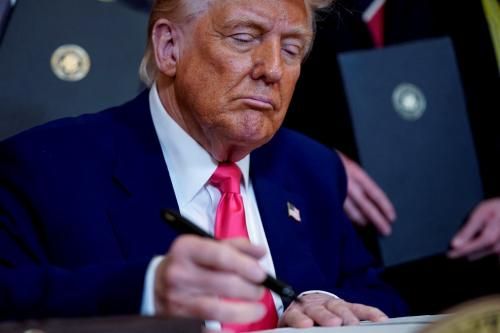Content from the Brookings Institution India Center is now archived. After seven years of an impactful partnership, as of September 11, 2020, Brookings India is now the Centre for Social and Economic Progress, an independent public policy institution based in India.
2018 has brought about a new set of draft/proposed Amendments to the Electricity Act 2003 (EA2003), which are an extension to the draft amendments introduced in Lok Sabha in 2014 but did not pass. EA2003 is the central act governing the power sector structure and policy in India, and any major amendments to it are once in a decade exhaustive exercise.
Amending the act is an opportunity to change the course of policy direction, design and implementation, to address the critical issues currently faced by the sector — more importantly, incorporating changes to tackle the future transitions envisaged in the sector.
The 2018 Amendments to EA2003 appear to focus on distribution companies (Discoms) as the problem area for the Indian power sector and hence, any amendments brought into force can have far reaching and long term implications towards future sustainability of Discoms in India.
The proposed Amendments span a spectrum of change, ranging from simple tweaks to modest modifications to dramatically different policies. The major thrust areas that the draft amendments propose are –
• Carriage and content separation – separation of the wires business and the retail business, creating 2 layers within today’s Discom world, the Distribution Licensees, and the Supply Licensees (DL and SL)
• Quality supply and procurement of power – mandate for licensees to establish medium and long-term PPAs to meet the annual average demand of power of the area which it has the obligation to serve. RPO and RGO obligations. Penalties extending to cancellation of license on failure to supply quality power.
• Subsidies and pricing – Removal of cross subsidies within three years. Subsidies to be paid directly to targeted consumers via DBT. Ceiling tariffs to be established for supply licensees.
• Oversight and regulation – Increased oversight by State Commissions, appropriate Government, CEA. Shift in momentum towards rule based approach.
• Innovation and transformation – significant mention of smarter grids, easing of norms for renewables, EVs, decentralised distributed generation.
There are potential concerns with each of them which remain unaddressed, like, the theory versus practice of carriage and content separation, uncertain dynamics and apportionment, quality mandated via 100% power purchase agreements (PPAs), governance challenges, regulatory mindset over an enabling one. These have been discussed in detail in the note.
Some of the items in the proposed Amendments aren’t “new” but are reframings or enforcements of what was already in the EA2003, but wasn’t achieved/enforced. Examples include reduction of cross subsidies to 20 percent, requirement for quality supply, etc. Now, there is mandate for 24×7 supply (a desirable goal) but it raises a new set of issues of how this mandate will be met. The government’s proposed Amendments to the EA2003 should make us circle back to certain fundamental questions: If there are complaints of lack of quality supply, and the proposed solution is new regulations asking for quality supply, aren’t there rules and regulations existing that mandate quality supply? Is this simply an enforcement problem? If not, are there structural deficiencies that have prevented quality supply so far?
Historically, we have always faced the twin challenges of enforcement and coordination. If central government policymakers believe states have been slow in improving performance, strengthening their institutions instead of taking away their flexibility (or even some powers) may be more sustainable in the long run (not to mention will create more state-level buy-in).
Another problem with the current amendments is that too much is left “to be determined” (TBD), and a few things are over-specified. A legislation must lay out the framework and intent, for which subsequent details via rules/regulations/notifications would apply. PPA and loss apportionment are already listed as issues left TBD. The challenge isn’t just the specifics or intent, but how do we get there? The only solution for this is deeper analysis, multi-stakeholder iteration and transparency.
In this note, we put forth the summary of the amendments and our analysis of the proposed changes. We end with specific comments on the draft Amendments as part of public comments, as an appendix, with line-item suggestions.
The Brookings Institution is committed to quality, independence, and impact.
We are supported by a diverse array of funders. In line with our values and policies, each Brookings publication represents the sole views of its author(s).




